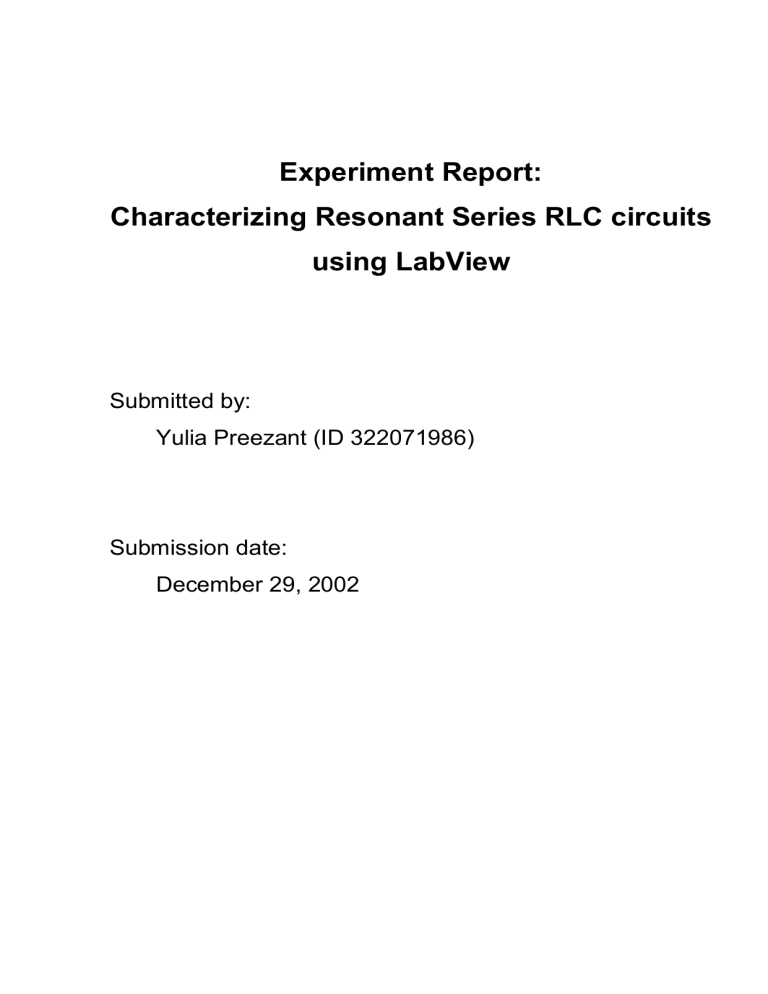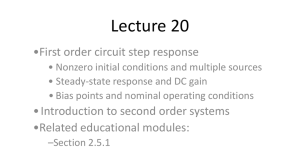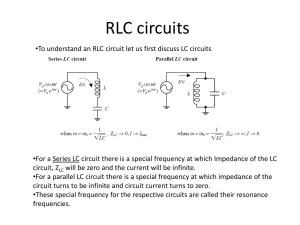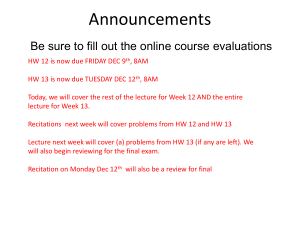Experiment Report:

Experiment Report:
Characterizing Resonant Series RLC circuits using LabView
Submitted by:
Yulia Preezant (ID 322071986)
Submission date:
December 29, 2002
Electronics Lab – RLC project
Table of contents:
Introduction __________________________________________________________________ 3
Theoretical background _________________________________________________________ 3
Resonant RLC circuit _________________________________________________________ 3
Program architecture and VIs hierarchy _____________________________________________ 5
SubVIs ______________________________________________________________________ 6
Prediction SubVI ____________________________________________________________ 6
Single Measurement SubVI ____________________________________________________ 7
Analysis SubVI ______________________________________________________________ 8
Main VI __________________________________________________________________ 10
Experimental data _____________________________________________________________ 12
Conclusions _________________________________________________________________ 14
Page 2
Electronics Lab – RLC project
Introduction
LabView is a power and flexible instrumentation and analysis software system. It is graphical programming language G that uses icons instead of lines of text to create applications
(programs called virtual instruments) 1 . LabView is integrated for communication with hardware such as GRIB. In this project we had to analyze the properties of RLC circuit using LabView software of National Instruments for data Acquisition via the GRIB Bus from Hewlett Packard instruments.
As it was introductory project, the main purposes were:
Familiarization with basic components complex programming environment of LabView
To develop instruments for data acquisition, signal analysis, and instrument control
To measure resonant series RLC circuits using LabView software
Theoretical background
LabView programs are called virtual instruments (VIs). VIs contains three main components: the front panel, the block diagram, and icon of connector pane. The user interacts with program through the front panel and we build the front panel with controls and indicators, which are the interactive input and output terminals of VI
2
. Graphical source code called a block diagram. The connector pane defines the inputs and outputs you can wire to the VI so you can use it as a SubVI.
Resonant RLC circuit
3
We have a series RLC circuit composed of an inductor L, a capacitor C, and a small resistor R. The Inductor has its own resistance R
L
from the coil winding.
1 Robert Bishop, Learning with LabView 6i, 2001
2 Introductory course booklet (tutorials) from National Instruments
3 http://www.tau.ac.il/~electro/doc_files/micro/Resonant_LCR%20using_Function_Generator.doc
Page 3
Electronics Lab – RLC project
A series RLC circuit exhibit a peak of the current when the driving frequency is equal to the resonance frequency of circuit.
The magnitude of the total impedance of the RLC circuit:
Z
R 2 tot
2
fL
2
1 fC
2
, R tot
R s
R
L
At very low frequencies, the capacitor acts like an open circuit; thus the total impedance
Z
goes to infinity and there is no current flowing through the circuit and hence no voltage across the series resistor, R s
. In the opposite limit of very high frequencies, the inductor acts like an open circuit. Again there is no current in the circuit, and hence no voltage across the series resistor, R s
. At the resonance frequency, the reactance of the capacitor X c cancels the reactance of the inductor X
L
leaving only the small resistance of R s
and the resistance of the coil windings,
R
L
. Now a large current flows through the circuit of magnitude
U
0
R tot
and a large maximum voltage U max
now appears across the series resistor R s
, namely U max
R tot s . And the resonance frequency f
0
is found by setting X
C
= X
L
, yielding f
0
2
1
LC
.
When we had measured the peak voltage U max
at the resonance frequency f
0
. We can also measure the two frequencies where the voltage across our series resistor R s
is only 70.7 % of
U max
. One frequency will be somewhat lower than the resonance frequency, which we will denote as f
Low
. The second frequency will be somewhat higher than the resonance frequency, which we will denote as f
Hi
.
The “Q” of the RLC circuit is defined as Q
f
0 f hi
f low
.
Formulas for programming:
R tot
R s
R
L
R add
2
Z R tot
2
fL
2
1 fC
2
U out
U R in s
| Z | f
0
2
1
LC
, Q
f
0 f hi
f low
Page 4
Electronics Lab – RLC project
Program architecture and VIs hierarchy
The art of successful programming in G is an exercise in modular programming. After dividing a given task into a series of simpler subtasks, you then construct a virtual instrument to accomplish each subtask. Modularity means that we can execute each SubVI independently, thus making debugging and verification easier
4
. Furthermore, our SubVIs we can use in other programs.
We dived our task on 3 parts:
Prediction (for scouring frequency only in required range)
Measurement
Analysis
Each of parts we divided according to comfortable and clear programming.
4 Robert Bishop, Learning with LabView 6i, 2001
Page 5
Electronics Lab – RLC project
SubVIs
Prediction SubVI
This SubVI executes 2 independent procedures:
Calculation theoretical values of resonant parameters
Calculation theoretical value of responsive voltage for given frequency
Input Cluster
Output Cluster
Frequency
Voltage
Front panel
We united all required input data (resistance, inductance, capacity and etc.) to the cluster for simplifying internal structure of block diagram
We united all output data
Given frequency in the given range
Corresponding voltage
We have to note that we set up voltage on HP arbitrary waveform generator in regime
Vpp (Peak-to-Peak). But the data that we need we acquire from HP multimeter in Vrms (Root
Mean Square) regime. For matching data we have to divide theoretical voltage by 2 .
Page 6
Block diagram
Electronics Lab – RLC project
Single Measurement SubVI
This SubVI is a main measurement unit. It consists of 2 SubVIs:
Write_SubVI. It prepares an instrument (HP arbitrary waveform generator) to establish required signal
Read_SubVI. It accommodates another instrument (HP multimeter) to data accepting.
A final output of SubVI – voltage in numeric and string formats.
Signal Frequency
Signal Amplitude
Timeout Value
In Error
Out error Message String
Out Error
Required characteristics of signal
Delays between measurements
Input Error report
Measured Voltage Numeric Voltage in different formats
Measured Voltage String
Output Error report
Front panel
Page 7
Block diagram
Electronics Lab – RLC project
Block diagrams of internal SubVI
We have to note that it was useful to insert timeout delay between measurements. The instruments have definite time for accepting and realizing a command. This time interval limits celerity but it necessary for normal execution
5
.
Analysis SubVI
5 About this property of program execution we was informed by instructor Oren Zarcin
Page 8
Electronics Lab – RLC project
In this SubVI we used a Sequence with 2 steps for serial operations of searching maximal value of voltage in file that formatted into 2 columns and searching frequencies corresponding to the 70,7% of maximal voltage (that found in the first operation).
Front panel
Block diagram
Searching for maximal voltage in the data file
Page 9
Electronics Lab – RLC project
Searching 2 frequencies with voltage equal to 70.7% of maximal value
Maybe this SubVI can be made easier if we have Mathlab Programming Environment on computer using Mathlab Script.
Main VI
This VI concatenates all of SubVIs and exhibits complete task. At start point of program
SubVI creates a new/replace old file for data that will be measured, and during process of measurement SubVI writes data in string format into the file. FOR_loop that has N steps performs the process of multimeasurement. We can alter N in accordance with required precision. Data from theoretical prediction and from measurements are performed in 2 formats:
Graph
2 clusters of values, which summarize theoretical and measured characteristics
Page 10
Front panel
Electronics Lab – RLC project
Block diagram
Page 11
Electronics Lab – RLC project
Experimental data
1. We measured directly some input parameters of RLC circuit (resistance of resistor R s
, resistance of inductor R
L
) using HP34401A Multimeter, which has accuracy 6 :
Accuracy +Temperature variation to each 1°C
Resistance
Voltage (AC: 1
750V)
10Hz
20kHz
20Hz
50kHz
50Hz
100kHz
0.003%
0.04%
0.1%
0.55%
0.003%
0.02%
0.04%
0.08%
2. Values of C and L were written on plastic basis of RLC circuit. Seeing them as an ideal without deviation from denoted values.
3. Additional resistance includes output resistance of HP 33120A Function arbitrary waveform generator (50 Ohm) and does not include resistance of wires. HP 33120A Function arbitrary waveform generator creates voltage waveform signal with accuracy of the amplitude -
1% 7 .
We studied 2 RLC circuits.
Experiment 1:
Experiment 2:
6 HP34401A Multimeter User’s guide
7 HP33120A Function/arbitrary Waveform Generator User’s Guide
Page 12
Electronics Lab – RLC project
Form the experimental data we can see that:
Measured peak of voltage (resonant peak) is shifted from theoretical peak site. It can be explained by inexact values of L and C (that we used without verification)
Measured resonant peak of voltage lower that theoretical
Theoretical Q and experimental Q differ. It can be explained by additional resistance that we did not take to consideration.
For precise results estimation we have to know all sources of error. Seeing on graph we can say only that curves look tenable.
Page 13
Electronics Lab – RLC project
Conclusions
We developed first virtual instrument
We can manage and control measurements in RLC circuits by our own driver
We can immediately compare theoretical and measured data
We can use our SubVIs in another different projects
We notified some nice properties of LabView:
Intuitively clear block diagram provides easy scheme understanding
Excellent debugging modes (“step by step”, “probe”)
Colors
Compatibility with MathLab
Great collection of examples
Also we descried some not good properties of LabView:
Not comfortable, undeveloped help libraries
Page 14








